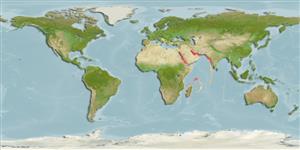Erugosquilla massavensis (Kossmann, 1880)
Red Sea mantis shrimp| Native range | All suitable habitat | Point map | Year 2050 |

|
| This map was computer-generated and has not yet been reviewed. |
| Erugosquilla massavensis AquaMaps Data sources: GBIF OBIS |
Classification / Names आम नाम | उपशब्द | CoL | ITIS | WoRMS
Malacostraca | Stomatopoda | Squillidae
Environment: milieu / climate zone / गहराई सीमा / distribution range पारिस्थितिकी
; गहराई सीमा 9 - 200 m (संदर्भ 128606), usually 20 - 40 m (संदर्भ 3497). Subtropical; 30°N - 13°N, 32°E - 44°E
Distribution देश | ऐफ ऐ ओ क्षेत्र | Ecosystems | संयोग | भूमिका
Western Indian Ocean: Red Sea. Introduced in the Mediterranean.
Length at first maturity / आकार / Weight / Age
परिपक्व अवधि: Lm ? range ? - ? cm Max length : 21.6 cm TL पुल्लिंग / अलिंग; (संदर्भ 365); common length : 15.0 cm TL पुल्लिंग / अलिंग; (संदर्भ 365)
Short description आकृति विज्ञान
Life cycle and mating behavior परिपक्व अवधि | पुनरुत्पत्ति | मछलीऔ का अंडे देना | Eggs | Fecundity | Larvae
Main reference
संदर्भ | संयोजक | सहयोगीयो
Manning, R.B. 1995 Stomatopod Crustacea of Vietnam: the legacy of Raoul Serène. Crustacean Research (Special No. 4): 1-339, figs. 1-142, pl. 1-38. (संदर्भ 3145)
IUCN Red List Status
(संदर्भ 130435: Version 2025-1)
CITES status (संदर्भ 108899)
CMS (संदर्भ 116361)
Threat to humans
Human uses
मात्स्यिकी: व्यापारिक
| FishSource |
साधन
अधिक जानकारी
संघटक आहार
आहार खपत
परभक्षी
इंटरनेट स्रोत
BHL | BOLD Systems | CISTI | DiscoverLife | FAO(Publication : search) | Fishipedia | GenBank (genome, nucleotide) | GloBI | Gomexsi | Google Books | Google Scholar | Google | PubMed | Tree of Life | Wikipedia (Go, खोज) | Zoological Record



